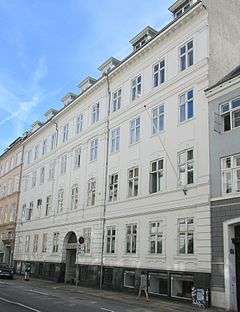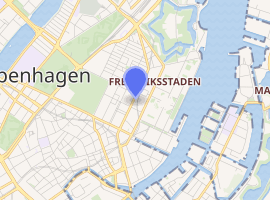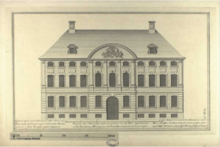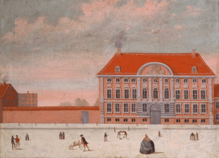Danneskiold-Laurvig Mansion
The Danneskiold-Laurvig Mansion is a historic building situated at Store Kongensgade 68 in central Copenhagen, Denmark. It was built in association with the Moltke's Mansion in Bredgade on the other side of the block.
| Danneskiold-Laurvig Mansion | |
|---|---|
Danneskiold-Laurvigs Palæ | |
 | |

| |
| General information | |
| Architectural style | Rococo |
| Location | Copenhagen |
| Country | Denmark |
| Coordinates | 55°41′3.41″N 12°35′16.38″E |
| Completed | 1746 |
| Client | Ferdinand Anton Danneskiold-Laurvig |
| Owner | SEB Pension |
| Design and construction | |
| Architect | Johann Adam Soherr |
History
Danneskiold-Laurvig family


Ferdinand Anton Danneskiold-Laurvig was the son of Ulrik Frederik Gyldenløve. When his father died in 1704 he inherited Gyldenløve's Little Mansion at the corner of Dronningens Tværgade and Bredgade as well as the County of Laurvig in Norway.[1] He purchased a number of smaller lots in Store Kongensgade in the 1720s. It is unclear when the building at Store Kongensgade was built. Most sources state that it was most likely built to a design by 0 ohann Adam Soherr in circa 1745. Ida Haugsted states that it was more likely built in circa 1720-30 to designs by Johan Cornelius Krieger. Krieger was also responsible for adaptingh the Gyldenløbe Mansion. A garden connected the two buildings and the new building in Store Kongensgade was referred to as Danneskiold-Laurvig's backyard" (Danneskiold-Laurvig's baggård). The new building was also known as Jernmagasinet ("The Iron Store") since stoves and other products from Danneskiold-Laurvig's extensive Fritzøe iron works in Laurvig in Norway were sold from its ground floor.[2]
Frederik Ludvig Danneskiold-Laurvig succeeded his father in 1754. He died without children in 1762 and all his holdings were therefore transferred to his brother Christian Conrad Danneskiold-Laurvig (1723-1783).
Frédéric de Coninck and Niels Lunde Reiersen
The building was on 3 April 1783 sold to the merchants Frédéric de Coninck and Niels Lunde Reiersen for 46,000 rigsdaler.
The building was at the time of the 1787 census home to three households with a total of 17 residents. Bookkeeper Thomas Christopher Radigend (76 y4s.) lived in the apartment in the western part of the ground floor with his second wife Anne (72 yrs.) and his sister's unmarried daughter Dorthea Helena (64 yrs.) as well as two maids. Counter Admiral ndreas Georg Herman Schultz (1718-1798) and his wife Anne Margrethe True (1737-1825) lived in the apartment on the first floor. The other members of their household were the 18-year-old girl Charlotte Lindemann (1767-1837) two maids and a servant.
The 40-year-old clerk Jørn Bøttger and his 28-year-old wife Christiane lived with their three children as well as their 27-year-old maid and the property's caretaker Lars Larsen in the apartment on the second floor.
Later owners
Reiersen sold his share of the building complex in Bredgade-Store Kongensgade to Frédéric de Coninck in 1789. Later that same year Frédéric de Coninck sold the Danneskiold-Laurvig Mansion to wine merchant Johan Ludwig Friederich Zinn. He was a nephew of Johann Ludvig Zinn with whom he stayed in the Zinn HOuse at the time of the 1787 census.
Architecture

The Rococo-style mansion is 11 bays wide and has a median risalit decorated with pilasters. It was expanded with an extra floor some time in the 19th century. It was listed on the Danish registry of protected buildings and places in 1954.[3]
List of owners
- 1704-1654 Ferdinand Anton Danneskiold-Laurvig]]
- 1754-1652 Frederik Ludvig Danneskiold-Laurvig
- 1754-1673
1783-1789 Frédéric de Coninck and Niels Lunde Reiersen
- 1789-1799 Frédéric de Coninck
- 1799-1810 Johan Ludwig Friederich Zinn
- 1810-1811 Meyer& Trier
- 1811-1811 Moritz Meyer Leopold Breslau von Bressendorff
- 1811-1816 Knud Bille Schack
- 1816-1829 Watt & Gordon
- 1829-1868 Joseph Owen
References
- "Moltke's Palace. The edifice". Moltkes Palæ. Retrieved 2011-10-03.
- "Store Kongensgade 68-68a-b". indenforvoldene.dk. Retrieved 23 August 2016.
- "Sag: Danneskjold-Laurvigs Palæ, Jernmagasinet" (in Danish). Kulturstyrelsen. Retrieved 23 August 2016.
External links
| Wikimedia Commons has media related to Danneskiold-Laurvigs Palæ. |